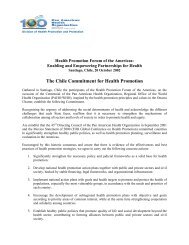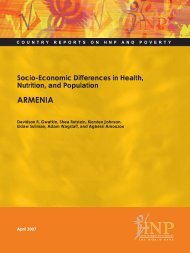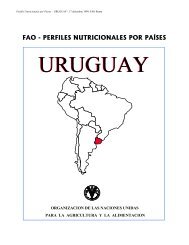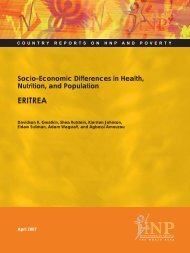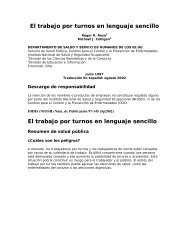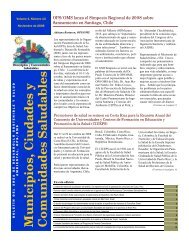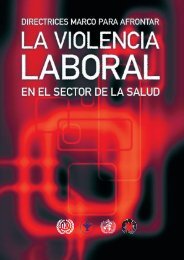Guidelines for drinking-water quality. Volume 1 - BVSDE
Guidelines for drinking-water quality. Volume 1 - BVSDE
Guidelines for drinking-water quality. Volume 1 - BVSDE
Create successful ePaper yourself
Turn your PDF publications into a flip-book with our unique Google optimized e-Paper software.
membrane filtration<br />
9308-1:1990 Detection and enumeration of coli<strong>for</strong>m organisms, thermotolerant coli<strong>for</strong>m<br />
organisms, and presumptive Escherichia coli - Part 1: Membrane filtration<br />
method<br />
9308-2:1990 Detection and enumeration of coli<strong>for</strong>m organisms, thermotolerant coli<strong>for</strong>m<br />
organisms, and presumptive Escherichia coli - Part 2: Multiple tube (most<br />
probable number) method.<br />
2.3 Recommendations<br />
2.3.1 General principles<br />
The provision of a safe supply of <strong>drinking</strong>-<strong>water</strong> depends upon use of either a protected high<strong>quality</strong><br />
ground <strong>water</strong> or a properly selected and operated series of treatments capable of reducing<br />
pathogens and other contaminants to negligible levels, not injurious to health. Treatment systems<br />
should provide multiple barriers to the transmission of infection. The processes preceding<br />
terminal disinfection should be capable of producing <strong>water</strong> of high microbiological <strong>quality</strong>, so that<br />
terminal disinfection becomes a final safeguard. Disinfection is also most efficient when the <strong>water</strong><br />
has already been treated to remove turbidity and when substances exerting a disinfectant<br />
demand, or capable of protecting pathogens from disinfection, have been removed as far as<br />
possible.<br />
The search <strong>for</strong> microbial indicators of faecal pollution is a “fail-safe” concept; in other words, if<br />
faecal indicators are shown to be present, then it must be assumed that pathogens could also be<br />
present. For this reason, faecal indicator bacteria must never be present in treated <strong>water</strong><br />
delivered to the consumer, and any detection should prompt immediate action to discover the<br />
cause and to take remedial action.<br />
The most specific of the readily detectable faecal indicator bacteria and the one present in<br />
greatest numbers in faeces is Escherichia coli and it is there<strong>for</strong>e recommended as the indicator of<br />
choice <strong>for</strong> <strong>drinking</strong>-<strong>water</strong>. The thermotolerant coli<strong>for</strong>m test can be used as an alternative to the<br />
test <strong>for</strong> E. coli. Thermotolerant coli<strong>for</strong>m bacteria are also recommended as indicators of the<br />
efficiency of <strong>water</strong> treatment processes in removing enteric pathogens and faecal bacteria, and<br />
<strong>for</strong> grading the <strong>quality</strong> of source <strong>water</strong>s in order to select the intensity of treatment needed. Total<br />
coli<strong>for</strong>m bacteria should not be present in treated <strong>water</strong> supplies and, if found, suggest<br />
inadequate treatment, post-treatment contamination, or excessive nutrients.<br />
2.3.2 Selection of treatment processes<br />
The selection of treatment processes to meet microbiological and chemical requirements can be<br />
made only after a careful detailed survey of the source and <strong>water</strong>shed, as outlined in section 6.2,<br />
including assessment of likely sources of pollution. Extensive bacteriological surveys, to include<br />
different seasons and weather conditions, can be used to assist in the selection. Regular<br />
bacteriological examination of source <strong>water</strong> after commissioning the treatment plant will establish<br />
long-term trends in <strong>quality</strong> and indicate whether there is a need to revise the treatment given.<br />
2.3.3 Treatment objectives<br />
The multiple-barrier concept of <strong>water</strong> treatment (see Chapter 6) requires that the removal of<br />
pathogens and of pollutants and biodegradable compounds should be as nearly complete as<br />
possible be<strong>for</strong>e terminal disinfection. Table 3 gives an example of per<strong>for</strong>mance objectives <strong>for</strong><br />
typical urban <strong>water</strong> treatment processes, based upon loadings and removal of turbidity and<br />
thermotolerant coli<strong>for</strong>m bacteria. These levels of per<strong>for</strong>mance are capable of being met and<br />
exceeded com<strong>for</strong>tably in normal operation. It is emphasized that the sequence of processes<br />
given in Table 3 is only one example from the many possible combinations of processes that are




